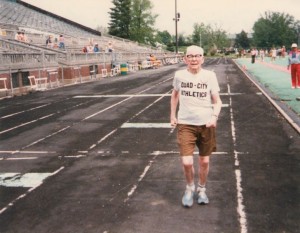By Lindsay Davey from Toronto Physiotherapy
 With aging populations and growing obesity rates, the total number of individuals suffering from chronic joint conditions including osteoarthritis is expected to nearly double between 2005 and 2030, reaching 41 million in the United States alone. This growth coincides with a proportional increase in health care intervention and expenditure. New estimates suggest that total hip arthroplasty for the treatment of hip osteoarthritis may grow by as much as 174% by 2030, to 572,000 primary (first time) surgeries each year in the United States (ref1).
With aging populations and growing obesity rates, the total number of individuals suffering from chronic joint conditions including osteoarthritis is expected to nearly double between 2005 and 2030, reaching 41 million in the United States alone. This growth coincides with a proportional increase in health care intervention and expenditure. New estimates suggest that total hip arthroplasty for the treatment of hip osteoarthritis may grow by as much as 174% by 2030, to 572,000 primary (first time) surgeries each year in the United States (ref1).
Today, physical rehabilitation is standard practice for the non-pharmacological management of osteoarthritis. Physiotherapy as a discipline is effective in managing the symptoms of osteoarthritis – pain, stiffness, weakness, locking, etc. Which of the specific physiotherapy modalities works best remains unclear (such as tissue and joint manipulation; exercise therapy; therapeutic ultrasound and laser; interferential current; transcutaneous electrical stimulation; education and behavior modification; braces and insoles; etc.).
The journal Osteoarthritis and Cartilage does a nice job of summarizing the most influential clinical studies of osteoarthritis rehabilitation published in the past year (ref2). The authors conclude that:
“Modalities such as 890-nm radiation [therapeutic laser], interferential current, short wave diathermy, ultrasound and neuromuscular functional electrical stimulation did not demonstrate benefit over sham controls in those with knee OA [osteoarthritis]”.
These results add to a growing body of clinically-relevant evidence that is generally supportive of these conclusions, but conflicting evidence exists. The latest Cochrane review 2010 (ref3) concluded that ultrasound may in fact reduce pain and improve function, but the quality of evidence was too low at the time to draw strong conclusions. Additional research is required to exclude these modalities entirely from osteoarthritis rehabilitation protocols, but it would be safe to say at the very least that they are no slam-dunk.
Of all the therapies evaluated over the last year, exercise therapy (a mainstay of physiotherapy rehabilitation) received the greatest support for improving both pain and function. All studies that examined exercise protocols demonstrated some benefit. Exercise therapy for osteoarthritis is well-supported by the broader body of rehabilitation research. In addition to exercise therapy, education with respect to self-management was also found to be beneficial. The scientific rationale for exercise promoting healing – mechanotherapy – is outlined in this Open Access BJSM paper (free full text HERE) (ref4).
Therapists need to keep on top of the latest research and modify their treatment methodology to reflect the best available data, keeping in mind that multiple independent randomized controlled clinical studies are needed in order to build conclusive evidence. The current best evidence suggests that exercise therapy should be a priority of osteoarthritis rehabilitation protocols.
References
- Nho S.J., Kymes S.M., et al. The burden of hip osteoarthritis in the United States: epidemiological and economic considerations. J Am Acad Orthop Surg. 2013;21 Suppl 1: S1-6.
- Davis A.M., MacKay C., Osteoarthritis Year in Review: Outcome of Rehabilitation. Osteoarthritis and Cartilage. 2013, doi: 10.1016/j.joca.2013.08.013.
- Rutjes A.W.S., Nuesch E., et al. Therapeutic ultrasound for osteoarthritis of the knee or hip. Cochrane Database Syst Rev. 2010 Jan 20;(1).
- Khan KM, Scott A. Mechanotherapy: how physical therapists’ prescription of exercise promotes tissue repair. Br J Sports Med. 2009 Apr;43(4):247-52. doi: 10.1136/bjsm.2008.054239. Epub 2009 Feb 24.
*******************************************************
Lindsay J Davey, MScPT, MSc, CAFCI, CDT
Lindsay Davey is a practicing physiotherapist and owner of Toronto Physiotherapy. She is affiliated with the University of Toronto through her roles as a clinical reasoning tutor for students in the Physical Therapy program and an active member of the Clinical Education Advisory Committee.